Copyright, Piracy, Creativity: A Music Essay for MAS214
VerifiedAdded on 2023/04/23
|6
|1389
|329
Essay
AI Summary
This essay, likely for a music course (MAS214), delves into the intricate relationship between copyright law and musical creativity. It addresses the argument that copyright may hinder creative processes, especially concerning cover versions and sampling, and explores the legal and economic implications of these practices. The essay further examines the ineffectiveness of copyright in combating music piracy, providing examples and discussing the challenges posed by digital technologies and the free-rider culture. The student references relevant readings and course materials to support their analysis, offering a comprehensive overview of copyright's impact on the music industry, touching on concepts such as intellectual property, originality, and the tension between creative techniques and legal frameworks. The essay highlights the evolving landscape of copyright in the digital age and the ongoing debates surrounding its role in protecting and promoting musical innovation.
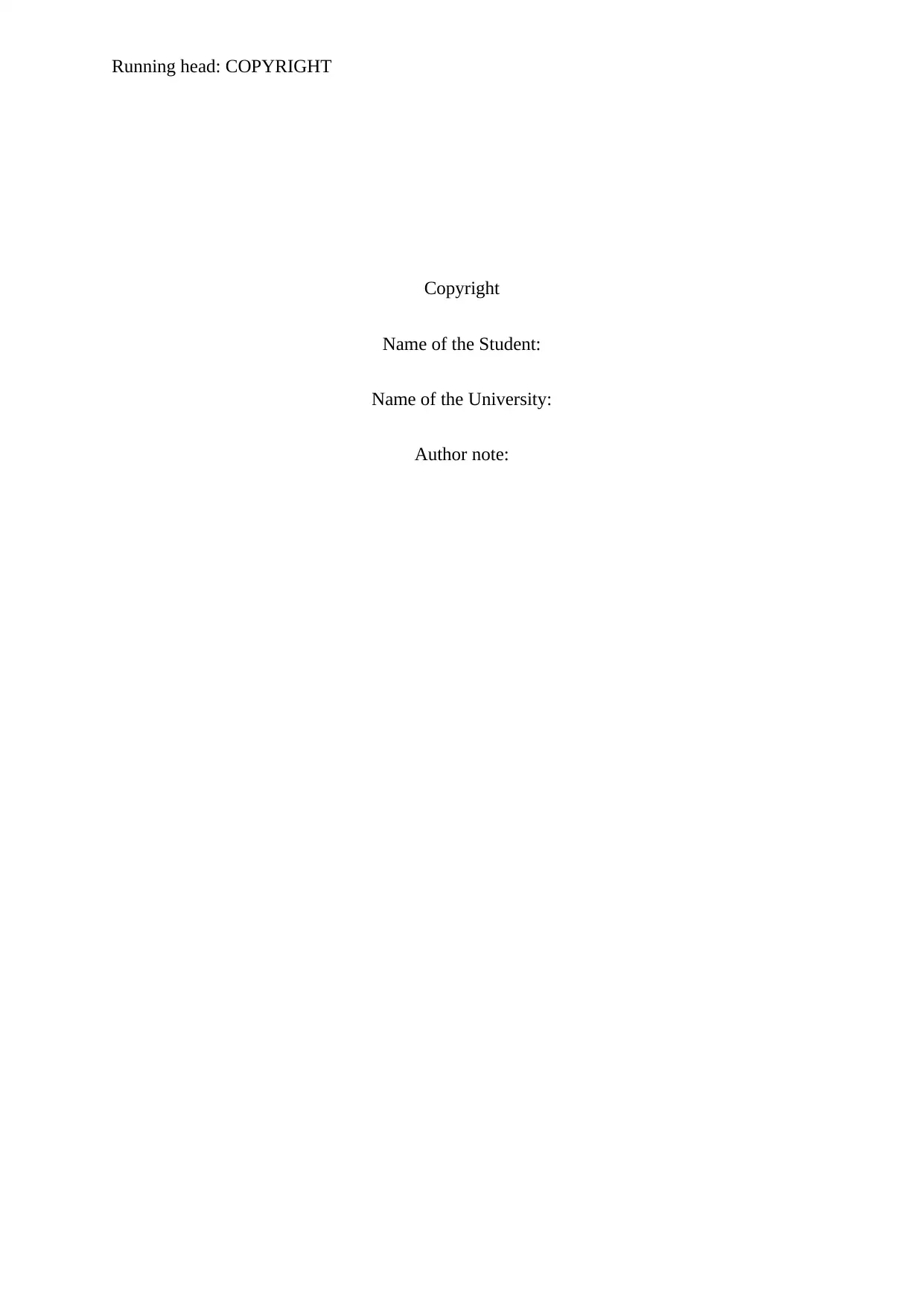
Running head: COPYRIGHT
Copyright
Name of the Student:
Name of the University:
Author note:
Copyright
Name of the Student:
Name of the University:
Author note:
Paraphrase This Document
Need a fresh take? Get an instant paraphrase of this document with our AI Paraphraser
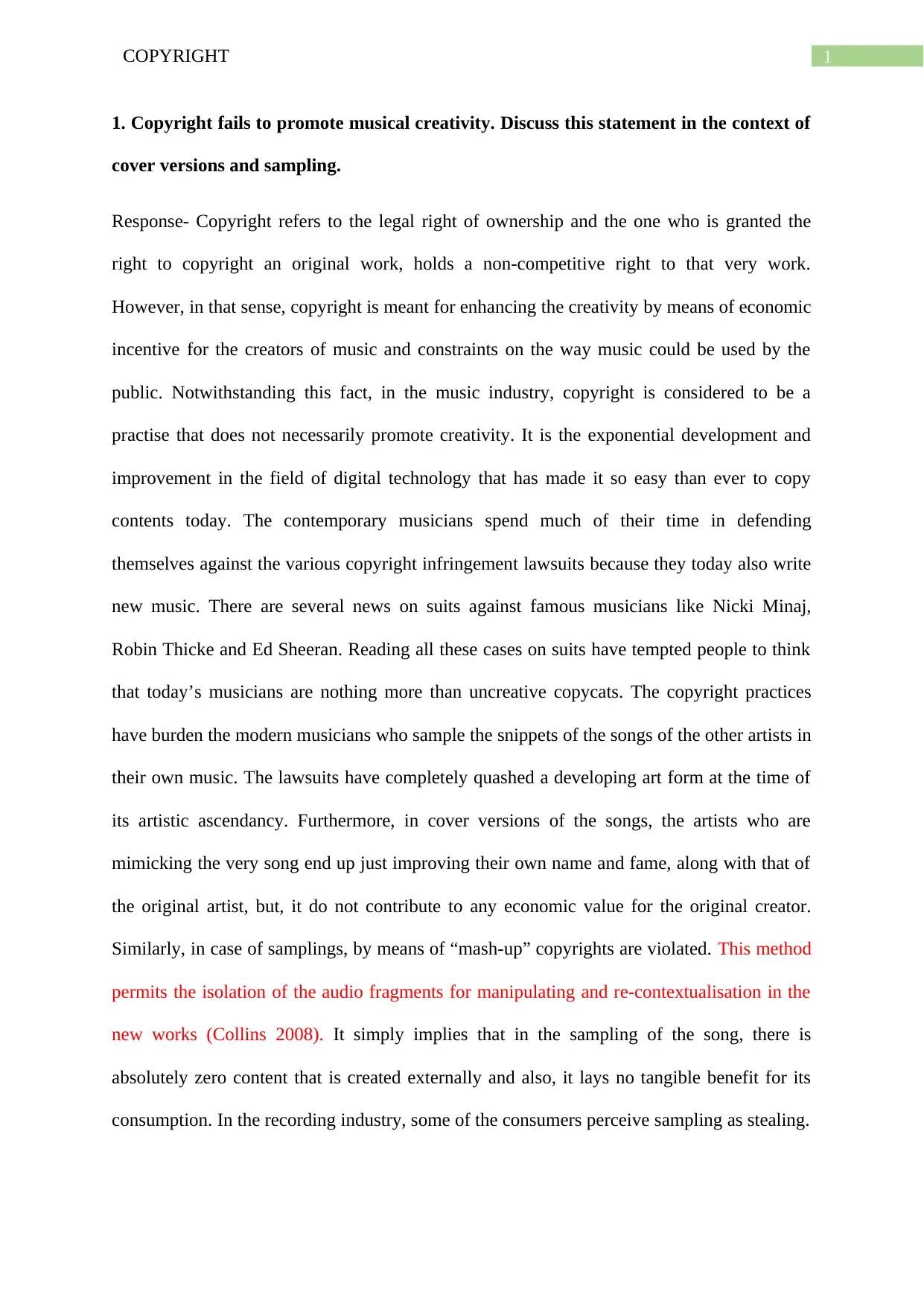
1COPYRIGHT
1. Copyright fails to promote musical creativity. Discuss this statement in the context of
cover versions and sampling.
Response- Copyright refers to the legal right of ownership and the one who is granted the
right to copyright an original work, holds a non-competitive right to that very work.
However, in that sense, copyright is meant for enhancing the creativity by means of economic
incentive for the creators of music and constraints on the way music could be used by the
public. Notwithstanding this fact, in the music industry, copyright is considered to be a
practise that does not necessarily promote creativity. It is the exponential development and
improvement in the field of digital technology that has made it so easy than ever to copy
contents today. The contemporary musicians spend much of their time in defending
themselves against the various copyright infringement lawsuits because they today also write
new music. There are several news on suits against famous musicians like Nicki Minaj,
Robin Thicke and Ed Sheeran. Reading all these cases on suits have tempted people to think
that today’s musicians are nothing more than uncreative copycats. The copyright practices
have burden the modern musicians who sample the snippets of the songs of the other artists in
their own music. The lawsuits have completely quashed a developing art form at the time of
its artistic ascendancy. Furthermore, in cover versions of the songs, the artists who are
mimicking the very song end up just improving their own name and fame, along with that of
the original artist, but, it do not contribute to any economic value for the original creator.
Similarly, in case of samplings, by means of “mash-up” copyrights are violated. This method
permits the isolation of the audio fragments for manipulating and re-contextualisation in the
new works (Collins 2008). It simply implies that in the sampling of the song, there is
absolutely zero content that is created externally and also, it lays no tangible benefit for its
consumption. In the recording industry, some of the consumers perceive sampling as stealing.
1. Copyright fails to promote musical creativity. Discuss this statement in the context of
cover versions and sampling.
Response- Copyright refers to the legal right of ownership and the one who is granted the
right to copyright an original work, holds a non-competitive right to that very work.
However, in that sense, copyright is meant for enhancing the creativity by means of economic
incentive for the creators of music and constraints on the way music could be used by the
public. Notwithstanding this fact, in the music industry, copyright is considered to be a
practise that does not necessarily promote creativity. It is the exponential development and
improvement in the field of digital technology that has made it so easy than ever to copy
contents today. The contemporary musicians spend much of their time in defending
themselves against the various copyright infringement lawsuits because they today also write
new music. There are several news on suits against famous musicians like Nicki Minaj,
Robin Thicke and Ed Sheeran. Reading all these cases on suits have tempted people to think
that today’s musicians are nothing more than uncreative copycats. The copyright practices
have burden the modern musicians who sample the snippets of the songs of the other artists in
their own music. The lawsuits have completely quashed a developing art form at the time of
its artistic ascendancy. Furthermore, in cover versions of the songs, the artists who are
mimicking the very song end up just improving their own name and fame, along with that of
the original artist, but, it do not contribute to any economic value for the original creator.
Similarly, in case of samplings, by means of “mash-up” copyrights are violated. This method
permits the isolation of the audio fragments for manipulating and re-contextualisation in the
new works (Collins 2008). It simply implies that in the sampling of the song, there is
absolutely zero content that is created externally and also, it lays no tangible benefit for its
consumption. In the recording industry, some of the consumers perceive sampling as stealing.
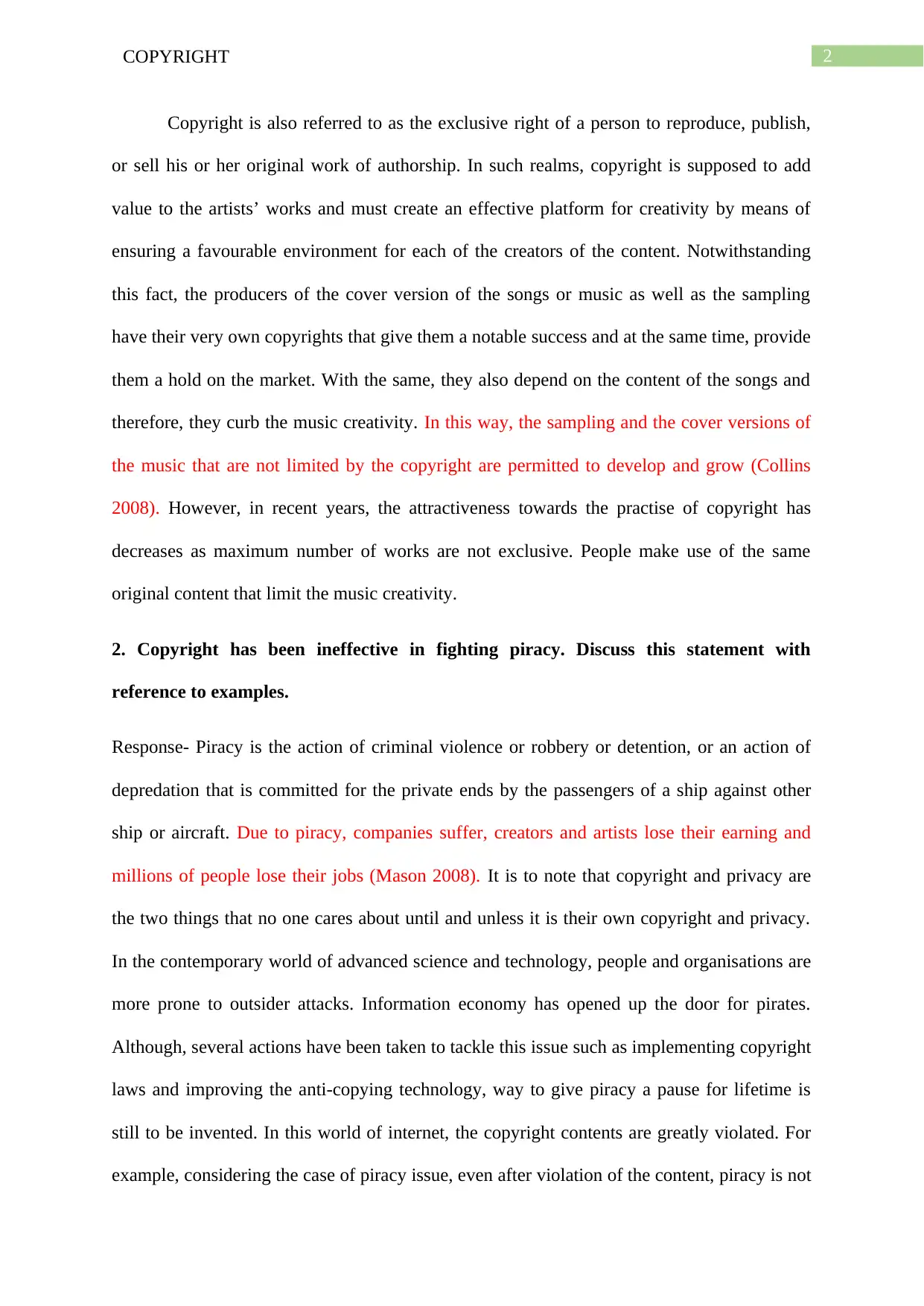
2COPYRIGHT
Copyright is also referred to as the exclusive right of a person to reproduce, publish,
or sell his or her original work of authorship. In such realms, copyright is supposed to add
value to the artists’ works and must create an effective platform for creativity by means of
ensuring a favourable environment for each of the creators of the content. Notwithstanding
this fact, the producers of the cover version of the songs or music as well as the sampling
have their very own copyrights that give them a notable success and at the same time, provide
them a hold on the market. With the same, they also depend on the content of the songs and
therefore, they curb the music creativity. In this way, the sampling and the cover versions of
the music that are not limited by the copyright are permitted to develop and grow (Collins
2008). However, in recent years, the attractiveness towards the practise of copyright has
decreases as maximum number of works are not exclusive. People make use of the same
original content that limit the music creativity.
2. Copyright has been ineffective in fighting piracy. Discuss this statement with
reference to examples.
Response- Piracy is the action of criminal violence or robbery or detention, or an action of
depredation that is committed for the private ends by the passengers of a ship against other
ship or aircraft. Due to piracy, companies suffer, creators and artists lose their earning and
millions of people lose their jobs (Mason 2008). It is to note that copyright and privacy are
the two things that no one cares about until and unless it is their own copyright and privacy.
In the contemporary world of advanced science and technology, people and organisations are
more prone to outsider attacks. Information economy has opened up the door for pirates.
Although, several actions have been taken to tackle this issue such as implementing copyright
laws and improving the anti-copying technology, way to give piracy a pause for lifetime is
still to be invented. In this world of internet, the copyright contents are greatly violated. For
example, considering the case of piracy issue, even after violation of the content, piracy is not
Copyright is also referred to as the exclusive right of a person to reproduce, publish,
or sell his or her original work of authorship. In such realms, copyright is supposed to add
value to the artists’ works and must create an effective platform for creativity by means of
ensuring a favourable environment for each of the creators of the content. Notwithstanding
this fact, the producers of the cover version of the songs or music as well as the sampling
have their very own copyrights that give them a notable success and at the same time, provide
them a hold on the market. With the same, they also depend on the content of the songs and
therefore, they curb the music creativity. In this way, the sampling and the cover versions of
the music that are not limited by the copyright are permitted to develop and grow (Collins
2008). However, in recent years, the attractiveness towards the practise of copyright has
decreases as maximum number of works are not exclusive. People make use of the same
original content that limit the music creativity.
2. Copyright has been ineffective in fighting piracy. Discuss this statement with
reference to examples.
Response- Piracy is the action of criminal violence or robbery or detention, or an action of
depredation that is committed for the private ends by the passengers of a ship against other
ship or aircraft. Due to piracy, companies suffer, creators and artists lose their earning and
millions of people lose their jobs (Mason 2008). It is to note that copyright and privacy are
the two things that no one cares about until and unless it is their own copyright and privacy.
In the contemporary world of advanced science and technology, people and organisations are
more prone to outsider attacks. Information economy has opened up the door for pirates.
Although, several actions have been taken to tackle this issue such as implementing copyright
laws and improving the anti-copying technology, way to give piracy a pause for lifetime is
still to be invented. In this world of internet, the copyright contents are greatly violated. For
example, considering the case of piracy issue, even after violation of the content, piracy is not
⊘ This is a preview!⊘
Do you want full access?
Subscribe today to unlock all pages.

Trusted by 1+ million students worldwide
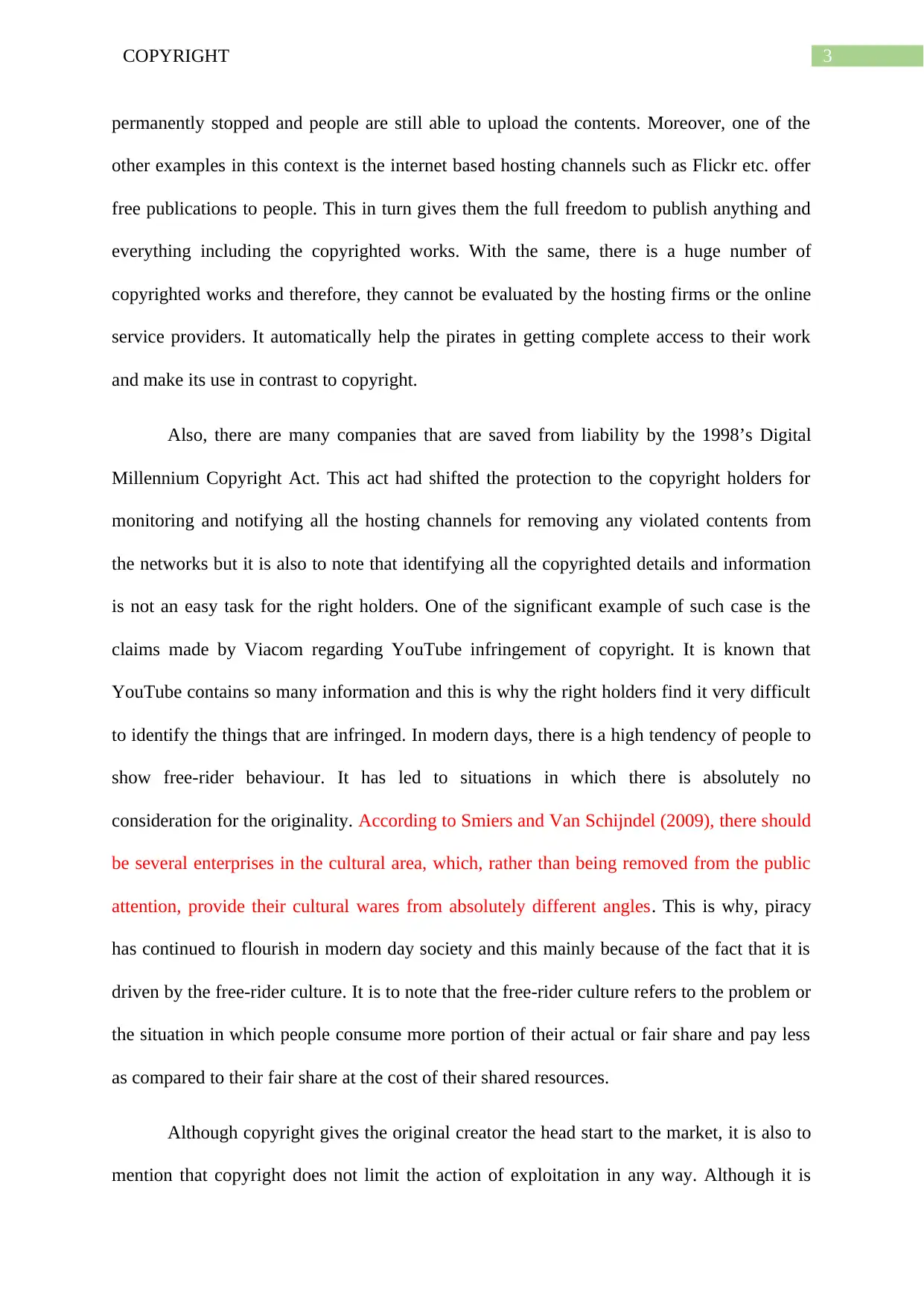
3COPYRIGHT
permanently stopped and people are still able to upload the contents. Moreover, one of the
other examples in this context is the internet based hosting channels such as Flickr etc. offer
free publications to people. This in turn gives them the full freedom to publish anything and
everything including the copyrighted works. With the same, there is a huge number of
copyrighted works and therefore, they cannot be evaluated by the hosting firms or the online
service providers. It automatically help the pirates in getting complete access to their work
and make its use in contrast to copyright.
Also, there are many companies that are saved from liability by the 1998’s Digital
Millennium Copyright Act. This act had shifted the protection to the copyright holders for
monitoring and notifying all the hosting channels for removing any violated contents from
the networks but it is also to note that identifying all the copyrighted details and information
is not an easy task for the right holders. One of the significant example of such case is the
claims made by Viacom regarding YouTube infringement of copyright. It is known that
YouTube contains so many information and this is why the right holders find it very difficult
to identify the things that are infringed. In modern days, there is a high tendency of people to
show free-rider behaviour. It has led to situations in which there is absolutely no
consideration for the originality. According to Smiers and Van Schijndel (2009), there should
be several enterprises in the cultural area, which, rather than being removed from the public
attention, provide their cultural wares from absolutely different angles. This is why, piracy
has continued to flourish in modern day society and this mainly because of the fact that it is
driven by the free-rider culture. It is to note that the free-rider culture refers to the problem or
the situation in which people consume more portion of their actual or fair share and pay less
as compared to their fair share at the cost of their shared resources.
Although copyright gives the original creator the head start to the market, it is also to
mention that copyright does not limit the action of exploitation in any way. Although it is
permanently stopped and people are still able to upload the contents. Moreover, one of the
other examples in this context is the internet based hosting channels such as Flickr etc. offer
free publications to people. This in turn gives them the full freedom to publish anything and
everything including the copyrighted works. With the same, there is a huge number of
copyrighted works and therefore, they cannot be evaluated by the hosting firms or the online
service providers. It automatically help the pirates in getting complete access to their work
and make its use in contrast to copyright.
Also, there are many companies that are saved from liability by the 1998’s Digital
Millennium Copyright Act. This act had shifted the protection to the copyright holders for
monitoring and notifying all the hosting channels for removing any violated contents from
the networks but it is also to note that identifying all the copyrighted details and information
is not an easy task for the right holders. One of the significant example of such case is the
claims made by Viacom regarding YouTube infringement of copyright. It is known that
YouTube contains so many information and this is why the right holders find it very difficult
to identify the things that are infringed. In modern days, there is a high tendency of people to
show free-rider behaviour. It has led to situations in which there is absolutely no
consideration for the originality. According to Smiers and Van Schijndel (2009), there should
be several enterprises in the cultural area, which, rather than being removed from the public
attention, provide their cultural wares from absolutely different angles. This is why, piracy
has continued to flourish in modern day society and this mainly because of the fact that it is
driven by the free-rider culture. It is to note that the free-rider culture refers to the problem or
the situation in which people consume more portion of their actual or fair share and pay less
as compared to their fair share at the cost of their shared resources.
Although copyright gives the original creator the head start to the market, it is also to
mention that copyright does not limit the action of exploitation in any way. Although it is
Paraphrase This Document
Need a fresh take? Get an instant paraphrase of this document with our AI Paraphraser
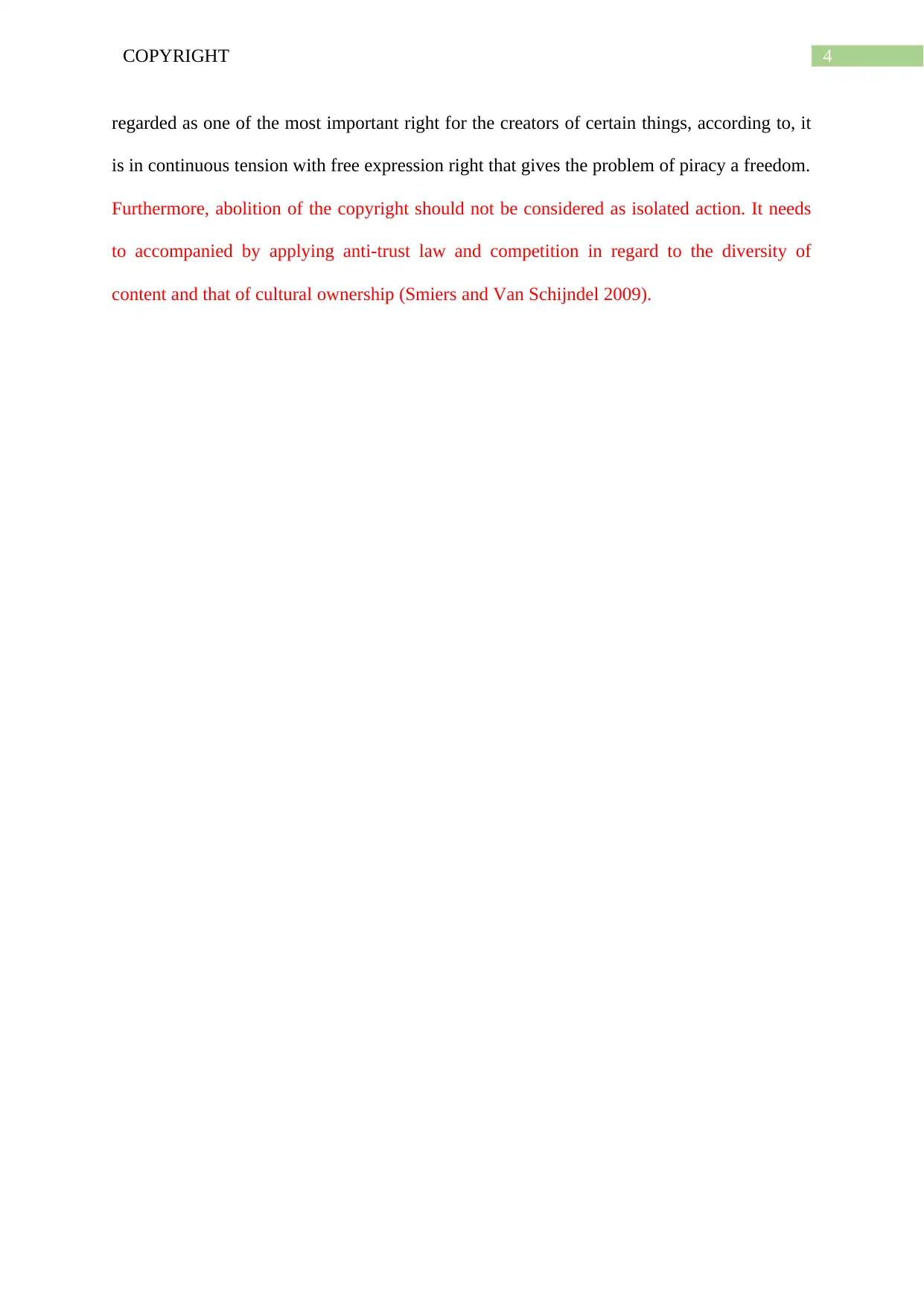
4COPYRIGHT
regarded as one of the most important right for the creators of certain things, according to, it
is in continuous tension with free expression right that gives the problem of piracy a freedom.
Furthermore, abolition of the copyright should not be considered as isolated action. It needs
to accompanied by applying anti-trust law and competition in regard to the diversity of
content and that of cultural ownership (Smiers and Van Schijndel 2009).
regarded as one of the most important right for the creators of certain things, according to, it
is in continuous tension with free expression right that gives the problem of piracy a freedom.
Furthermore, abolition of the copyright should not be considered as isolated action. It needs
to accompanied by applying anti-trust law and competition in regard to the diversity of
content and that of cultural ownership (Smiers and Van Schijndel 2009).
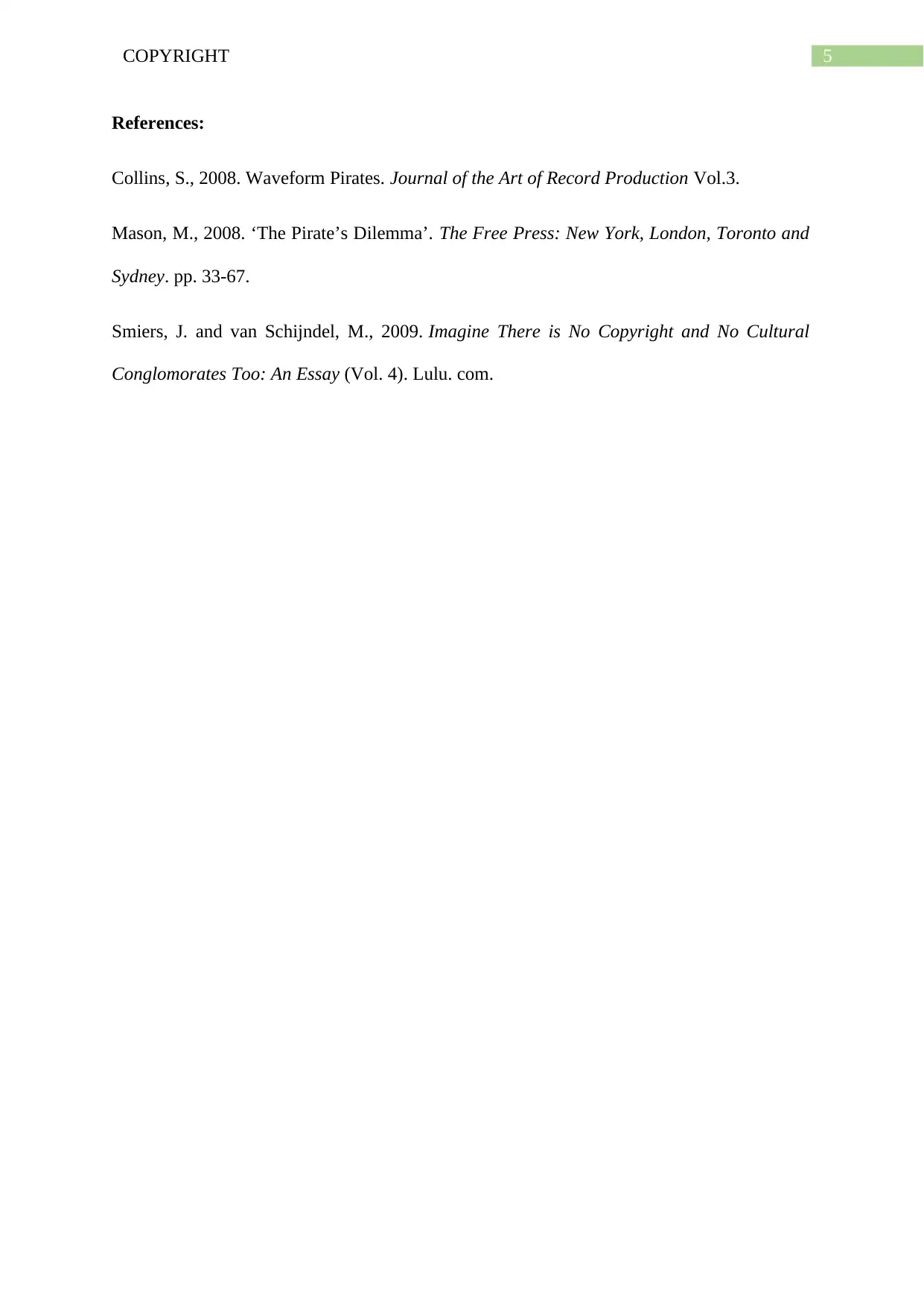
5COPYRIGHT
References:
Collins, S., 2008. Waveform Pirates. Journal of the Art of Record Production Vol.3.
Mason, M., 2008. ‘The Pirate’s Dilemma’. The Free Press: New York, London, Toronto and
Sydney. pp. 33-67.
Smiers, J. and van Schijndel, M., 2009. Imagine There is No Copyright and No Cultural
Conglomorates Too: An Essay (Vol. 4). Lulu. com.
References:
Collins, S., 2008. Waveform Pirates. Journal of the Art of Record Production Vol.3.
Mason, M., 2008. ‘The Pirate’s Dilemma’. The Free Press: New York, London, Toronto and
Sydney. pp. 33-67.
Smiers, J. and van Schijndel, M., 2009. Imagine There is No Copyright and No Cultural
Conglomorates Too: An Essay (Vol. 4). Lulu. com.
⊘ This is a preview!⊘
Do you want full access?
Subscribe today to unlock all pages.

Trusted by 1+ million students worldwide
1 out of 6
Related Documents
Your All-in-One AI-Powered Toolkit for Academic Success.
+13062052269
info@desklib.com
Available 24*7 on WhatsApp / Email
![[object Object]](/_next/static/media/star-bottom.7253800d.svg)
Unlock your academic potential
Copyright © 2020–2025 A2Z Services. All Rights Reserved. Developed and managed by ZUCOL.





